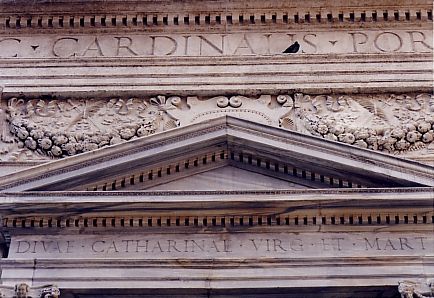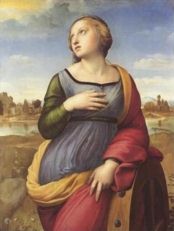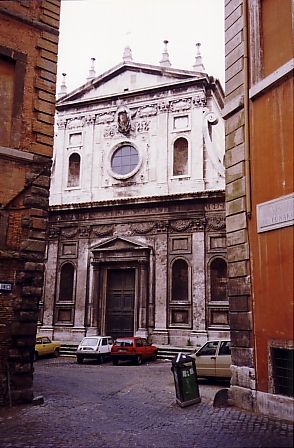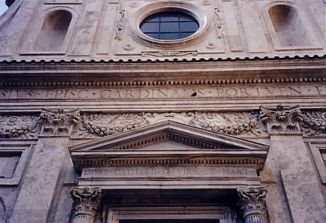
 |
|
The Name In 1564 the architect Guidetto Guidetti completed the harmonious fašade of
the church of Santa Caterina dei Funari. The church is dedicated to the virgin martyr
Saint Catherine of Alexandria, who was converted to Christianity after receiving a vision. During
the persecution of Maximinus she offered to debate with pagan philosophers. Her powerful arguments
converted many of them, and they were martyred. When Catherine managed to convert the empress,
Maximinus ordered Catherine to be broken on a wheel, but as the saint touched it the wheel was destroyed.
Then she was beheaded. - Funari means rope-makers in Italian and alludes to the fact that the local
rope-makers plied their trade in the vicinity of the church. |
 |
|---|
 |
The Iconography of the Fašade The two-storeyed fašade, which resembles that of Santo Spirito in Sassia, has
an intricate iconographical programme. Guidetto Guidetti, a pupil of Michelangelo, had been commissioned by cardinal Federico
Cesi to design the fašade. The lower storey, which consists of five bays, has three Corinthian pilasters on each side of the
portal. Between the pilasters there are big empty semicircular niches. Underneath and above these niches there are rectangular
panels. The porch is flanked by two fluted Corinthian columns, which in their turn support a triangular pediment. The capitals
of the columns have cornucopias as well as cherubs' heads and festoons. Between the capitals of the lower storey there are several
iconographical elements. Over the opulent fruit-festoons of the central bay we can see the symbol of martyrdom - the palmbranch, and
Saint Catherine's instrument of martyrdom - the sword. The corresponding space of the side-bays is decorated with the saint's
intended instrument of martyrdom - the wheel. Also there are roses here, perhaps alluding to the former name of this church -
Santa Caterina della Rosa. On the frieze above there is an inscription in Latin telling us that cardinal Federico Cesi built
this church in 1564. Underneath the Latin word for "cardinal" we may detect some unusual words of information, that Guidetto
Guidetti was the architect, and that Bartolomeo da Casal Monferrato was the master mason. The upper storey has three bays. The outer bays of the lower storey are connected to the upper storey with volutes. The central bay has a rose-window, possibly another allusion to the name "della Rosa". In fact this architectural motif is also called rose-Catherine-wheel, which recalls the intended instrument of martyrdom of the saint. The rose-window has a quadratic frame with roses in its corners. The window is surmounted by the escutcheon of the Cesi family surrounded by festoons and other decorations. As in the lower tier there are empty niches and panels between the pilasters. Between the capitals there are oval cartouches. The fašade is crowned by a big triangular pediment with acroteria in the form of vases, and a cross in the middle. |
|---|
 |
|---|